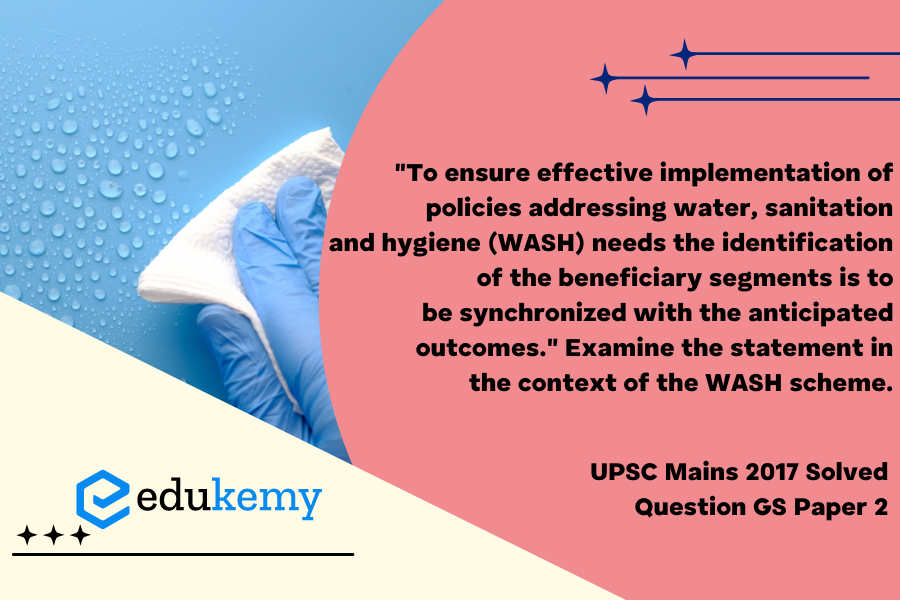In the realm of water, sanitation, and hygiene (WASH) policies, the pivotal factor for their successful execution lies in the meticulous alignment of beneficiary identification with envisioned outcomes. The adage, “To ensure effective implementation of policies addressing WASH needs, the identification of the beneficiary segments is to be synchronized with the anticipated outcomes,” encapsulates the essence of strategic planning within the WASH scheme. Targeting specific demographics for intervention, such as vulnerable communities or regions with limited access to clean water and sanitation facilities, ensures that the policies directly address the root causes of the issues at hand. This synchronization between beneficiary identification and expected outcomes not only enhances the precision of resource allocation but also amplifies the overall impact of WASH initiatives, fostering sustainable improvements in public health and well-being. In scrutinizing this statement within the context of the WASH scheme, it becomes evident that strategic alignment is the linchpin for the scheme’s efficacy, driving positive transformations in communities grappling with water, sanitation, and hygiene challenges.
Tag: Social Issues; issues related to development.
Contents
Decoding the Question:
- In the Introduction, briefly write about the WASH scheme.
- In Body,
- Discuss how the scheme ensures identification of beneficiaries and synchronizes it with outcomes.
- Mention some challenges with the scheme and suggest some measures to address issues.
- In Conclusion, mention the overall significance of WASH scheme.
Answer:
India is one of the developing countries that has come out with WASH schemes to address the challenges of health and sanitation in urban and rural areas. The WASH i.e., Water, Sanitation, and Hygiene program provides expertise and interventions aimed at saving lives and reducing illness by improving global access to healthy and safe water, adequate sanitation, and improved hygiene. It works on long-term prevention and control measures for improving health, reducing poverty, and improving socio-economic development.
How WASH Links Beneficiaries with Outcomes:
- It is committed to SDG6 i.e., clean water and sanitization which is fundamental for ensuring public health and sustainable development.
- It significantly reduces the incidence and spread of microbial-causing diseases like- diarrhea, which is responsible for death among children under five years old.
- It also reduces the use of antibiotics, which facilitates in controlling Antimicrobial resistance.
- It involves both Central and Local governments, which promotes a bottom-up planning approach.
- The lack of WASH facilities can prevent students from attending school, impose a burden on women and diminish productivity of people.
- In the long run it also impacts poverty reduction and socio-economic development.

Challenges Faced Implementing the WASH Scheme:
- WASH sectors come under concurrent subjects and both central and state governments can legislate on it. The collection of data related to WASH schemes are generally done at state level but it suffers from many discrepancies.
- It has a complex and multifaceted approach which is leading to a lack of coordination among stakeholders.
- The lack of quality data and accountability measures is also hindering the success of the scheme.
- The needs and barriers for segments of the population differ and consequently, the strategies also need to be customized for the different segments. Therefore, policymakers are gradually moving away from a “one size fits all” approach to a more beneficiary-centric approach.
- Climate change and unprecedented growth of urban population create issues like new diseases, lack of basic amenities, etc.
Measures to Strengthen the WASH Scheme:
- Link WASH scheme to other similar initiatives like; climate change, Neglected Tropical Disease control programme, etc.
- The engagement of the community and adequate research & data collection facilities can make the scheme more effective.
- The creation of a large and sustainable infrastructure is also necessary for improving sanitization.
- Mass awareness, behavioral change, and accountability measures can facilitate long-term growth.
A traditional approach has been to segment the beneficiaries based on geographical and social context. Population was therefore segmented as rural, urban, low-income, and so on. Recently there has been a trend to segment the beneficiaries based on the human life cycle. Beneficiaries are thus segmented as children, adolescents, adults, senior citizens, and so on. A more robust policy would help in achieving better identification of the beneficiary segments to be synchronized with the anticipated outcomes.
In case you still have your doubts, contact us on 9811333901.
For UPSC Prelims Resources, Click here
For Daily Updates and Study Material:
Join our Telegram Channel – Edukemy for IAS
- 1. Learn through Videos – here
- 2. Be Exam Ready by Practicing Daily MCQs – here
- 3. Daily Newsletter – Get all your Current Affairs Covered – here
- 4. Mains Answer Writing Practice – here


